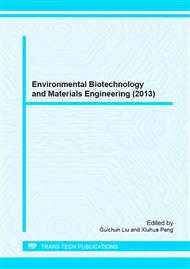[1]
WANG Guang-hua ZHA Zhen-lin LI Jian LI Jun-rong. Treatment of Waste Steel-pickling Sulphuric Acid. Industrial Safety and Environmental Protection, 2009. 35(8): 13-15.
Google Scholar
[2]
WAN Jin-Bao, TAO Kun, WANG Rong. Study on integrative treatment of hydrochloric (sulfuric) acid pickling wastewater in steel plan. Water Resources Protection, 2006. 22(2): 62-64.
Google Scholar
[3]
Gabriel Meruane, T.V., Bacterial oxidation of ferrous iron by Acidithiobacillus ferrooxidans in the pH range 2. 5–7. 0. Hydrometallurgy, 2003. 71: 149-158.
DOI: 10.1016/s0304-386x(03)00151-8
Google Scholar
[4]
A. Giaveno, L.L.P.C., Bioleaching of zinc from low-grade complex sulfide ores in an airlift by isolated Leptospirillum ferrooxidans. Hydrometallurgy, 2007(89): 117-126.
DOI: 10.1016/j.hydromet.2007.07.002
Google Scholar
[5]
Tunde V. Ojumua, G.S.H.J., The kinetics of ferrous-iron oxidation by Leptospirillum ferriphilum in continuous culture the effect of temperature. Biochemical Engineering Journal, 2009. 46(2): 161-168.
DOI: 10.1016/j.bej.2009.05.001
Google Scholar
[6]
DENG EnJian, YANG ZhaoHui, ZENG Guang-Ming, XU Zhengyong. General Situation in Thiobacillus Ferrooxidans Study. [J]. Gold Science and Technology, 2005, 13(5): 8-12.
Google Scholar
[7]
DENG Enjian, YANG Zhaohui, ZENG Guangming, TAO Ran. Screening of Culture Conditionfor Thiobacillus Ferrooxidans and Desulfurisation Test [J]. Environmental Science and Technology, 2005, 28(6): 1-3.
Google Scholar
[8]
ZHANG Zaihai, QIU Guanzhou, HU Yuehua, LIU Jianshe. The Investigation of the Colony Isolation of Thiobacillus Ferrooxidans. Multipurpose Utilization of Mineral Resources [J]. 2001, 1(1): 19-22.
Google Scholar
[9]
BI Yin-li, HU Yu, SU Gao-hua, ZHAO Bin. Isolation of Thiobaxillus ferrooxidans and their desulphurization to coal wastes [J] Journal of Liaoning Technical University, 2007, 26.
Google Scholar
[10]
Khalid A M, Batti T. An improved solid medium for isolation, enumeration and genetic investigations of autotrophic iron and sulphur oxidizing bacteria [J]. Apply Microbiol Biotechnology, 1993, 39: 259-263.
DOI: 10.1007/bf00228616
Google Scholar
[11]
Garcia, Mukai J K, Andrade C B. Growth of Thiobacillus ferrooxidans on solid medium: effects on some surface-active agents on colony formation[J]. Apply Microbiol, 1992, 38: 279-282.
DOI: 10.2323/jgam.38.279
Google Scholar
[12]
WANG Shimei, ZHOU Lixiang. Arenovated approach for increasing colony count efficiency of Thiobacillus ferrooxidans and Thiobacillus thiooxidans: Double-layer Plates [J]. Acta Scientiae Circumstantiae, 2005, 25(10): 1418-1420.
Google Scholar
[13]
LI Shenglin, Analytical Chemistry Experiment [M]. Tianjin: Nankai University Press, 1987, 73-770(GB/T6730. 8-1986).
Google Scholar


